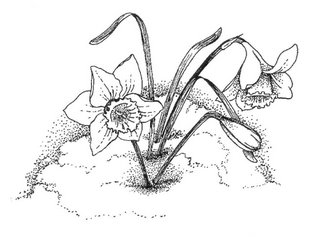 To anyone who's lived in places where the same snow remains on the ground from October until April, our winters are incomprehensible. This year, during most of the calendar winter, we've enjoyed weather that fits more properly in fall, even summer. Winter weather, with snow and cold and all, is frequently part of our calendar spring. Just when plants ought to, and indeed are trying desperately to, put out flowers and new leaves, they get killer frosts and heavy branch-breaker snows. Daffodil snows, I call them. We aren't the only ones tricked by Colorado's weather.
To anyone who's lived in places where the same snow remains on the ground from October until April, our winters are incomprehensible. This year, during most of the calendar winter, we've enjoyed weather that fits more properly in fall, even summer. Winter weather, with snow and cold and all, is frequently part of our calendar spring. Just when plants ought to, and indeed are trying desperately to, put out flowers and new leaves, they get killer frosts and heavy branch-breaker snows. Daffodil snows, I call them. We aren't the only ones tricked by Colorado's weather.Is our weather getting trickier every year, or are we only imagining it? It's hard to take the long view and evaluate whether this is global warming we're seeing, or just a "normal" drought cycle. Okay, things are looking up today (I'm snowed in as I write this), but can a few heavy spring snowstorms make enough of a difference? Actually, this February storm alone has changed Denver Water's statistic for the Upper Colorado River Basin from 80% of normal to 95% within a few days. We need, however, to distinguish the mountain snowpack that quenches our thirst from the local precipitation that supports the life around us, just as we need to distinguish the calendar seasons—only an astronomical guideline—from what's going on in the real world.
Although only about a quarter of our moisture falls as snow, the large areas it falls on feed the streams that fill our reservoirs. March and April snows put down moisture that can soak deeply into soils. More than half our moisture, though, comes during the growing season—between May and September—and almost all of that is directly and immediately used by plants. Thus, the effect of dry periods—whether they disturb us or our local environments more—depends on when they strike. Last summer, which ranked among the five hottest and driest in a 123-year record, clearly disturbed plant life throughout our area, as moisture eluded them just when they needed it most.
The largest part of the structure of a tree is the water-carrying plumbing that brings us spring. This tissue we call wood is dead, but not dry as long as the tree lives. (The living parts of a tree are tiny fractions at either end—tips of roots, tips of stems—and a continuous paper-thin cylinder of living tissue that connects them.) The wood itself is made up of long, narrow dead cells, connected end-to-end like straws, through which water and nutrients are pushed and pulled up into the leaves and needles. The physics of water movement in a straw, or in a plant, requires that the water column be continuous from one end to the other, or from root to bud. Water pushes into roots from wet soil, but what happens when the soil is empty of water? No nourishment flows into roots; the upper ones wither away. From deeper layers, the fine roots continue to search for water; if there is none, they too die. As our warm, dry chinook winds suck more water from plants than can be replaced from dusty soils, the water column in the stem breaks, and spring begins to look less and less likely. Anyone who's carried a bouquet of wildflowers home to mom knows what happens when water is no longer being continuously forced or drawn into a stem.
We hardly ever think of sap, and when we do use the word, it's often to label something that isn't very impressive. Yet sap is responsible for creating glory for us each spring. Although sap is often pulled up the trunk of a tree or the stems of a shrub, especially by active leaves, it is also pushed. These pressures underground, of water moving from soil into root, from root into bud and leaf, make spring seem an undeniable force that simply must happen. Metaphors of rebirth, awakening, and hope flow into us, as into our religions, our poetry, and our visual arts, from the simple force of sap rising. It's in the spirit of those metaphors that we go looking for signs of spring, even in March. And often find them. I've seen green buds on the wax currants in mid-March, albeit icy ones. Some of our early flowers have even been known to appear in a February warm spell. I looked for Easter daisies in February, but no luck this time. Our temperatures welcomed them, but our dry soils wouldn't give them that underground push.
Fortunately, much of a Colorado "winter" occurs six weeks after the groundhogs have their say, often even after the arrival of calendar spring. I want to believe the almanac, which promises us a cold, wet March. Perhaps it will come in time to bring us a "sappy" spring after all.
Copyright, S.L. White, 2006. Illustration copyright Jan Ratcliffe.
Originally published in Upbeat, March 1995.
2 comments:
Very pretty design! Keep up the good work. Thanks.
»
Your are Nice. And so is your site! Maybe you need some more pictures. Will return in the near future.
»
Post a Comment